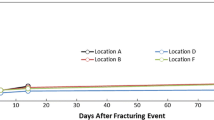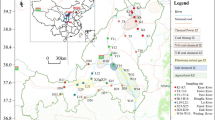Abstract
There is a growing concern over the contamination of surface water and the associated environmental and public health consequences from the recent proliferation of hydraulic fracturing in the USA. Petroleum hydrocarbon-derived contaminants of concern [benzene, toluene, ethylbenzene, and xylenes (BTEX)] and various dissolved cations and anions were spatially determined in surface waters around 15 coalbed methane fracking wells in Sullivan County, IN, USA. At least one BTEX compound was detected in 69% of sampling sites (n = 13) and 23% of sampling sites were found to be contaminated with all of the BTEX compounds. Toluene was the most common BTEX compound detected across all sampling sites, both upstream and downstream from coalbed methane fracking wells. The average concentration of toluene at a reservoir and its outlet nearby the fracking wells was ~2× higher than other downstream sites. However, one of the upstream sites was found to be contaminated with BTEX at similar concentrations as in a reservoir site nearby the fracking well. Calcium (~60 ppm) and sulfates (~175 ppm) were the dominant cations and anions, respectively, in surface water around the fracking sites. This study represents the first report of BTEX contamination in surface water from coalbed methane hydraulic fracturing wells.



Similar content being viewed by others

References
Adeyemo OK, Kroll KJ, Denslow ND (2015) Developmental abnormalities and differential expression of genes induced in oil and dispersant exposed Menidia beryllina embryos. Aquat Toxicol 168:60–71
Bolden AL, Kwiatkowski CF, Colborn T (2015) New Look at BTEX: are ambient levels a problem? Environ Sci Technol 49:5261–5276
Carpenter DO (2016) Hydraulic fracturing for natural gas: impact on health and environment. Rev Environ Health 31:47–51
Ferrar KJ, Michanowicz DR, Christen CL, Mulcahy N, Malone SL, Sharma RK (2013) Assessment of effluent contaminants from three facilities discharging Marcellus Shale wastewater to surface waters in Pennsylvania. Environ Sci Technol 47:3472–3481
Finkel ML (2015) The human and environmental impact of fracking. How fracturing shale for gas affects us and our World, ABC-CLIO
Fisher C (2014) Determination of anions and cations in produced water from hydraulic fracturing. http://www.learnpharmascience.com/tablet-apps/issue12/article3/5_AN71255.pdf. Accessed on December 19th 2016.
Gallegos TJ, Varela BA (2015) United State Geological Survey (USGS) Scintific Investigations Report 2014–5131. Trends in Hydraulic Fracturing Distributions and Treatment Fluids, Additives, Proppants, and Water Volumes Applied to Wells Drilled in the United States from 1947 through 2010—Data Analysis and Comparison to the Literature. https://pubs.usgs.gov/sir/2014/5131/. Accessed on December 19th 2016
Getzinger GJ, O’Connor MP, Hoelzer K, Drollette BD, Karatum O, Deshusses MA, Ferguson PL, Elsner M, Plata DL (2015) Natural gas residual fluids: sources, endpoints, and organic chemical composition after centralized waste treatment in Pennsylvania. Environ Sci Technol 49:8347–8355
Greenwell K and Keller B (2013) Indiana oil and gas update. http://heinonline.org/HOL/LandingPage?handle=hein.journals/twlr19&div=23&id=&page=. Accessed on December 19th 2016.
Gregory KB, Vidic RD and Dzombak DA (2011) Water management challenges associated with the production of shale gas by hydraulic fracturing. Elements 7:181–186.
Gross SA, Avens HJ, Banducci AM, Sahmel J, Panko JM, Tvermoes BE (2013) Analysis of BTEX groundwater concentrations from surface spills associated with hydraulic fracturing operations. J Air Waste Manag Assoc 63:424–432
Haluszczak LO, Rose AW, Kump LR (2013) Geochemical evaluation of flowback brine from Marcellus gas wells in Pennsylvania, USA. Appl Geochem 28:55–61
Howarth RW, Ingraffea A, Engelder T (2011) Natural gas: should fracking stop? Nature 477:271–275
Moore TA (2012) Coalbed methane: a review. Int J Coal Geol 101:36–81
Parker KM, Zeng T, Harkness J, Vengosh A, Mitch WA (2014) Enhanced formation of disinfection byproducts in shale gas wastewater-impacted drinking water supplies. Environ Sci Technol 48:11161–11169
Peng C, Lee JW, Sichani HT, Ng JC (2015) Toxic effects of individual and combined effects of BTEX on Euglena gracilis. J Hazard Mater 284:10–18
Perrin J, Cook T (2016) Hydraulically fractured wells provide two-thirds of U.S. natural gas production. http://www.eia.gov/todayinenergy/detail.php?id=26112. Accessed on December 19th 2016
Peters JG (1981) United States Geological Survey (USGS). Effects of Surface Mining on Water Quality In a Small Watershed, Sullivan County, Indiana. Open File Report 81–543. https://pubs.er.usgs.gov/publication/ofr81543. Accessed on December 19th 2016.
USEPA (2012) United States Environmental Protection Agency (US EPA) National Recommended Water Quality Criteria. http://water.epa.gov/scitech/swguidance/standards/criteria/current/index.cfm. Accessed on December 19th 2016
Van Voast WA (2003) Geochemical signature of formation waters associated with coalbed methane. http://www.mbmg.mtech.edu/pdf/wayne-cbmgeochem.pdf. Accessed on December 19th 2016
Warner NR, Christie CA, Jackson RB, Vengosh A (2013) Impacts of shale gas wastewater disposal on water quality in western Pennsylvania. Environ Sci Technol 47:11849–11857
Webb E, Bushkin-Bedient S, Cheng A, Kassotis CD, Balise V, Nagel SC (2014) Developmental and reproductive effects of chemicals associated with unconventional oil and natural gas operations. Rev Environ Health 29:307–318
Acknowledgements
The authors would like to acknowledge Laura Demarest of the West Central Indiana Water Alliance for providing GIS data that was utilized to create Fig. 1, and Dr. Frederick Soster of DePauw University for providing feedback regarding the project. We would also like to thank Dr. Jeanette Pope of DePauw University for providing laboratory accessories and access to an ion chromatograph. Funding for this project was provided by the Science Research Fellows program at DePauw University.
Author information
Authors and Affiliations
Corresponding authors
Rights and permissions
About this article
Cite this article
Meszaros, N., Subedi, B., Stamets, T. et al. Assessment of Surface Water Contamination from Coalbed Methane Fracturing-Derived Volatile Contaminants in Sullivan County, Indiana, USA. Bull Environ Contam Toxicol 99, 385–390 (2017). https://doi.org/10.1007/s00128-017-2139-x
Received:
Accepted:
Published:
Issue Date:
DOI: https://doi.org/10.1007/s00128-017-2139-x



